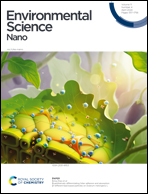Biogenic synthesis of dual-emission chlorophyll-rich carbon quantum dots for detection of toxic heavy metal ions – Hg(ii) and As(iii) in water and mouse fibroblast cell line NIH-3T3†
Abstract
Due to the excessive residues and serious adverse effects, it is urgent to develop an efficient method to detect Hg2+ and As3+ in drinking water to protect human health. In this study, a novel fluorometric sensor based on chlorophyll-rich carbon quantum dots (CQDs) for the detection of Hg2+ and As3+ ions was developed. The dual emitting (blue-green and red) CQDs were synthesized by a one-step solvothermal method using plumeria plant leaves as precursors. When Hg2+ ions were added in the presence of CQDs, the red emission (676 nm) of the CQDs was quenched (OFF), while in the presence of As3+ ions, the blue-green emission (485 nm) was enhanced (ON). The detection limits of 0.99 nM for Hg2+ and 12.15 nM for As3+ were validated for the proposed sensor. The biocompatibility, cytotoxicity, and bioimaging of the CQDs were investigated in the mouse fibroblast cell line NIH-3T3. The cellular uptake was also studied under the influence of Hg2+ and As3+ ions. Moreover, the novel chlorophyll-rich CQD-based fluorometric “ON–OFF” dual probe sensor was successfully applied to detect Hg2+ and As3+ in real water systems as well as in the mouse fibroblast cell line.



 Please wait while we load your content...
Please wait while we load your content...